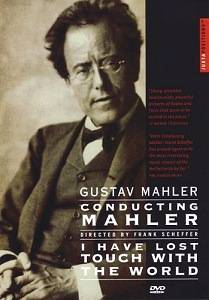These two films
by distinguished Dutch documentary film maker Frank Scheffer
concentrate on the symphonies of Mahler. The first takes its
inspiration from the 1995 Mahler Fest in Amsterdam, where the
three great orchestras associated with Mahler – the Concertgebouw,
Vienna and Berlin Philharmonics – took centre-stage with the
five conductors listed above, to perform all the numbered symphonies
and Das Lied von der Erde.
What the film basically
gives us is a 70-minute potted version of the rehearsals, plus
a generous helping of ‘talking heads’-style interviews with
the conductors, the lion’s share of which goes, understandably
perhaps, to Haitink and Chailly, with Abbado in third and only
a couple of brief (but telling) contributions from Rattle and
Muti. Given the stature and intelligence of these musicians
as Mahlerians, it really goes without saying that everything
they say is of some significance. I’m sure I’m not alone in
enjoying hearing great musical figures articulate their thoughts
and ideas about great music; I can’t resist quoting just one
here, when Haitink talks about Mahler’s ‘talent for suffering’
finding its way into his music.
Regarding the musical
sequences, we see Haitink rehearsing symphonies 2, 3, 6, 10
(adagio only, of course) and Das Lied (favouring
a baritone, Thomas Hampson); Chailly rehearsing 1 and 8, Abbado
in 5 and 9, Muti in 4 and Rattle in 7. The technique is simple
and uniform, with the camera largely staying on the conductor
as the music unfolds, sometimes in long paragraphs (as with
Rattle), sometimes with much stopping and starting. Either way
it’s illuminating, particularly in sequences such as the offstage
band in the Resurrection, which proves an acoustic problem
for Haitink and his assistant. We’re not always told which conductor
is rehearsing which orchestra – sometimes it’s more obvious
than others – but this is hardly a problem; they are all supremely
talented players and the results, even in rehearsal, are refined
and often exhilarating. The surprise for me was Muti, not because
I ever doubted his ability, but because I’d never heard him
in Mahler; this makes me itch to hear a complete 4th.
Sound quality is
pretty good and there are individual, named chapters (‘Mahler
the Modernist’, ‘Vienna at the Turn of the Century’ etc.) though
it makes obvious sense to run the film unbroken, making the
chapters of negligible value.
The second, slightly
shorter film is a more in-depth look at the 9th,
this time with much longer extracts and the spoken analysis
from Chailly and Mahler biographer-supreme, Henry-Louis de la
Grange. It was obviously made to coincide with Chailly’s imminent
departure from the orchestra, something which adds an extra
poignancy to the proceedings. It’s good to get longer chunks
- virtually the whole of the first movement exposition and a
good ten minutes of the finale – and typically intelligent observations
from conductor and academic. We get the tie-in to other works
- a longer extract of Hampson’s Das Lied is featured
again - and though it’s fair to say there’s nothing a seasoned
Mahlerian won’t already know, illustrated talks like this are
very enlightening in their own way. There’s even time for a
joke between Chailly and the orchestra at the film’s very opening,
when the Concertgebouw’s second horn plays his A natural a semitone
higher, eliciting first a look of shock from the conductor,
followed by a wry observation that the resulting harmony is
worthy of Schoenberg’s Moses und Aaron! As the adagio
nears its end, Scheffer’s use of the famous Rückert Lieder
title for the film emerges as a masterstroke, and there is as
obvious layer of emotion for Chailly and this great orchestra
as their partnership also reaches a conclusion.
Sound quality is
much better on this second film and picture quality throughout
is good. Definitely one for Mahlerians but also a serious contender
for lovers of the mysterious art of conducting, especially just
what goes on in the rehearsal room.
Tony Haywood

![]() Directed by Frank Scheffer
– 1996 (Film 1) and 2004 (Film 2)
Directed by Frank Scheffer
– 1996 (Film 1) and 2004 (Film 2)![]() ALLEGRI FILMS DVD 9D512
ALLEGRI FILMS DVD 9D512
![]() [132:00]
[132:00]